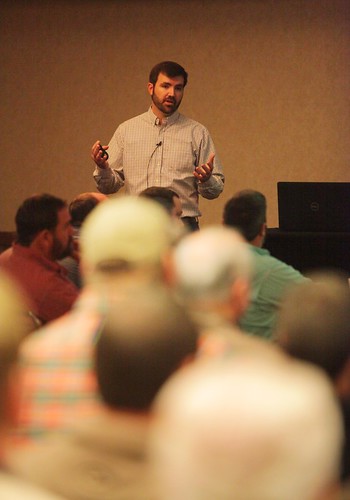Water, soil and pests hot topics at annual crop management conference
By Ryan McGeeney
U of A System Division of Agriculture
Jan. 19, 2018
Fast Facts:
- About 450 attended conference
- Agronomists, entomologists and other experts delivered recent finding on current issues
- Industry updates are also part of annual meeting
(723 words)
(Download this story in MS Word format here.)
NORTH LITTLE ROCK, Ark. – Hundreds of growers, consultants and other agriculture industry professionals gathered this week in North Little Rock to learn about the latest research and findings in soil health, pest management and other aspects of modern farming in the state at the Arkansas Crop Management Conference.
Jason Kelley, wheat and feed grains agronomist for the University of Arkansas System Division of Agriculture, said about 450 individuals attended the three-day conference. Kelley also serves as treasurer for the Arkansas Crop Protection Association, one of five institutions (including the Division of Agriculture) responsible for presenting the conference.
Several presenters discussed the the benefits of using cover crops during fallow periods, something agronomists and other experts have been emphasizing in the region for several years.
Glenn Studebaker, extension entomologist for the Division of Agriculture, said thorough planning and timing are key in the use of cover crops to help reduce the spread of Palmer amaranth, commonly known as pigweed, and other weeds.
“Two of the key questions I always ask are: ‘What kind of cover crop you going to plant, and when are you going to burn it down?’ Because that’s how you eliminate the ‘green bridge,’” Studebaker said.
The “green bridge” refers to live cover crops that can provide sustenance to various pests between cash crops if there isn’t a period of elimination between.
“Think about how our recent winters have gone,” he said. “This spring, you might be able to get away with planting into a green cover crop without a pyrethroid, but it’s risky.”
Tom Barber, extension weed scientist for the Division of Agriculture, said growers should also consider the specific pests they are trying to control when choosing cover crops.
“Before you plant a cover crop, you need to think about why you’re planting it,” Barber said. “If you’re in a county where pigweed has taken over, you need to plant for that.”
Barber spoke at length about current approaches to fighting the spread of pigweed in counties where it has developed resistance to PPO chemistries, a trend that was first detected more than a decade ago.
“The problem we have is that the PPO chemistry has been such a reliable tool for us, in managing pigweed over the years, that a lot of growers still think they can get by with one more year of it. And that’s where we have the issues,” he said. “The more seed that’s produced every year that escapes, the more enhanced that problem’s going to be moving forward.”
Barber said that many growers are returning to older chemistries that pre-date the use of PPO pesticides.
Nick Seiter, an entomologist formerly with the Division of Agriculture who now conducts research for the University of Illinois at Champagne, updated attendees on the presence of red banded stink bugs, the invasive subtropical insect that increased significantly in Arkansas after two mild winters. This winter’s sub-freezing temperatures are expected to kill off as much as 95 percent of the insect’s populations in Arkansas.
“The mortality you see in the field is always going to be a little less than you see in the laboratory,” Seiter said. “Insects find leaf litter and other things that might help them survive. But these temperatures have been sustained enough that we expect to see a significant impact.”
Jarrod Hardke, extension rice agronomist for the Division of Agriculture, spoke about the plausibility of planting row rice, which requires different irrigation techniques from the typical method of growing rice in Arkansas, which uses a flood and levee system. Hardke said about 40,000 acres of row rice were planted in 2017, about 4 percent of total rice acreage.
“There’s a growing interest in it, and how we can do it successfully” Hardke said. “I don’t think anyone’s under the illusion that we’re ever going to move to something like half our rice acres being row rice, but it’s not going to go away. It has potential.”
He said the primary incentives for farmers to grow row rice are lower indirect costs, such as labor hours and time put on equipment.
“The time your labor is spending in those fields, pulling and managing levees, installing and removing gates — you’re taking all of those elements out of it,” Hardke said.
To learn about row crops in Arkansas, contact your local Cooperative Extension Service agent or visit www.uaex.uada.edu.
About the Division of Agriculture
The University of Arkansas System Division of Agriculture’s mission is to strengthen agriculture, communities, and families by connecting trusted research to the adoption of best practices. Through the Agricultural Experiment Station and the Cooperative Extension Service, the Division of Agriculture conducts research and extension work within the nation’s historic land grant education system.
The Division of Agriculture is one of 20 entities within the University of Arkansas System. It has offices in all 75 counties in Arkansas and faculty on five system campuses.
Pursuant to 7 CFR § 15.3, the University of Arkansas System Division of Agriculture offers all its Extension and Research programs and services (including employment) without regard to race, color, sex, national origin, religion, age, disability, marital or veteran status, genetic information, sexual preference, pregnancy or any other legally protected status, and is an equal opportunity institution.
# # #
Media Contact: Mary Hightower
Dir. of Communication Services
U of A System Division of Agriculture
Cooperative Extension Service
(501) 671-2126
mhightower@uada.edu
Related Links
